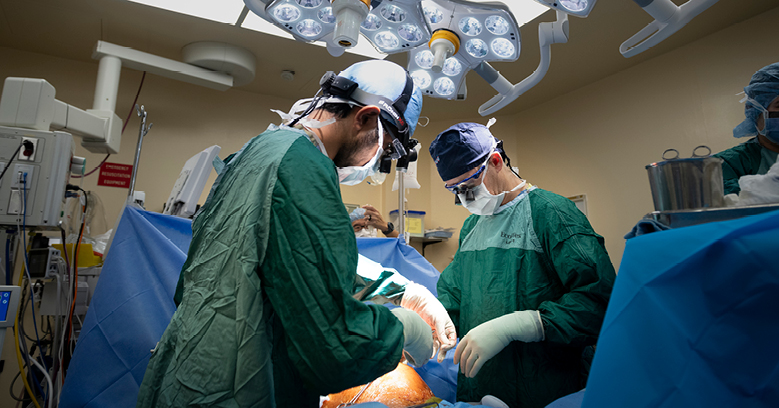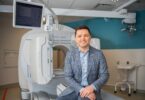It’s a first-in-Canada program that offers patients with advanced colorectal cancer a unique form of treatment, and hope for a cure. Dr. Michael Raphael, medical oncologist, gives an insider’s look into the Hepatic Artery Infusion Pump (HAIP) chemotherapy program at Sunnybrook’s Odette Cancer Centre.
What Exactly Is HAIP?
HAIP is a special form of treatment for individuals where colon or rectal cancer (colorectal cancer) has spread to the liver. It is used when there are too many spots of cancer within the liver to allow a surgeon to safely remove them all. HAIP offers a chance of cure to these patients by delivering targeted doses of chemotherapy, directly to the liver, through an implanted pump. The goal is to make the disease in the liver small enough that a surgeon can go in and remove what is left.
Who Is a Good Candidate?
This treatment is best for fit, motivated patients who want to adopt an aggressive treatment philosophy. Patients need to have no or very limited cancer outside the liver, and be well enough to undergo an operation. Special testing is done to ensure that the blood flow to the liver is appropriate to allow the treatment to be safely offered.
If a patient is a good fit, they’ll undergo surgery to have the pump implanted into the abdomen and a small catheter fed directly into the liver. This procedure usually takes about one to two hours, sometimes longer if the original cancer in the colon or rectum needs to be taken out at the same time.
Following that, a special nuclear medicine scan is done. Dye is injected into the body to make sure it’s reaching both lobes of the liver, and not going anywhere else in the body. That’s how we know it’s safe to start using the treatment pump. We start filling the HAIP with chemotherapy about two weeks after surgery.
What Is So Special About HAIP Therapy?
The liver is the most common site of spread for colorectal cancer. For patients with cancer spread that is limited to the liver, intensifying therapy directly to the liver makes a lot of sense.
The liver has several special properties that make HAIP therapy a very good option. First, it has two sources of blood supply (the portal vein and the hepatic artery). Studies have shown that healthy liver tissue preferentially gets it blood supply and nutrients from the portal vein, whereas growing cancer cells preferentially steal their blood supply and nutrients from the hepatic artery. That means we can preferentially treat cancer cells while sparing healthy liver by directly infusing chemotherapy into the hepatic artery.
The liver is also a unique organ; it’s where many drugs are first broken down by the body. This is called the “first-pass effect.” That means we can give very high doses of medicine directly to the liver, allow them to kill cancer cells, and know that very little chemotherapy ever gets to the rest of the body to cause side effects.
We use a very special type of chemotherapy called FUDR. It’s brought into Canada specifically for the HAIP program, and not used anywhere else. About 99 per cent of the drug is broken down in the liver itself, so we can give really high doses without the risks of side effects that are typically associated with chemotherapy, like nausea. Studies have shown we can give 400 times the dose because it’s going directly into the liver.
How Many Patients Have Had HAIP?
About 105 patients have had the pump implanted at Sunnybrook since HAIP’s inception eight years ago. I work closely with Dr. Paul Karanicolas, the surgeon who implants the pump, and many others. HAIP is such a special program that involves a coordinated, multidisciplinary team approach to care, with close collaboration across surgical oncology, medical oncology (chemotherapy), interventional radiology, nuclear medicine and oncology nursing. A patient’s first point of contact is Christina Kim, the nurse practitioner who oversees the program and helps every patient navigate the HAIP journey.
How Effective Is HAIP?
We’re seeing some really dramatic improvements in our patients. About 25 per cent who have HAIP can go on to have surgery to remove the cancer from their liver. These were patients who didn’t have that option before. Of the 105 patients that we’ve treated, about four have had their cancer completely disappear on imaging. Four others have had a good enough response to go on to other potentially curative therapies, such as a liver transplant.
It’s amazing because in many areas of oncology that I treat, there isn’t a realistic chance of cure. Through HAIP, Sunnybrook’s Odette Cancer Program is able to offer something that no one else can: a source of hope.
Has the Program Evolved?
While some patients with small spots on the liver can have surgery to remove it, they still face about at least a 50 per cent chance of the cancer coming back. In the United States, some centres are using HAIP to prevent this recurrence.
The other area where HAIP has shown evidence of success across the world is in treating bile duct cancers. At Sunnybrook, we are hoping to expand the use of HAIP in the future to apply to different types of patients and cancers.
How Can People Learn More?
Because we are the only program of its kind in Canada, we get referrals from all over the country. We can only treat patients residing in Ontario, however, because of our funding structure. More details are available on Sunnybrook’s HAIP webpage.








